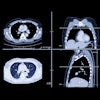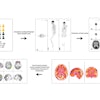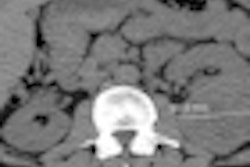The new guidelines calling for CT lung screening of only high-risk individuals would result in thousands of people unnecessarily dying of lung cancer because they were never screened, according to screening advocates. At the same time, there are powerful forces in the U.S. that will be forced to spend potentially billions of dollars if CT lung screening is implemented on a wide scale.
In the May 20 issue of the Journal of the American Medical Association, the American College of Chest Physicians (ACCP) and the American Society of Clinical Oncology (ASCO) issued guidelines that call for low-dose CT screening of individuals ages 55 to 74 with smoking histories of 30 pack-years or more. The groups said that their analysis of the literature did not find clear-cut evidence that CT screening's benefits outweigh the harms in lower-risk individuals.
Should they be widely adopted, the ACCP guidelines will leave out many people who are still considered to be at elevated risk for lung cancer, albeit not as high as someone who has smoked for 30 years. This would include workers in the nuclear industry, workers who have been exposed to asbestos, those with a family history of lung cancer, and individuals with chronic obstructive pulmonary disease and emphysema.
People who have had a previous cancer are at ultrahigh risk, according to Dr. Frederic Grannis, clinical professor of thoracic surgery at City of Hope National Medical Center in Duarte, CA. An individual with a previous lung cancer has a 20% risk of developing a second lung cancer. However, they can't be screened under the new ACCP guidelines published in JAMA. Cancer patients typically undergo cancer surveillance for several years after a diagnosis.
Dr. Ella Kazerooni, professor of radiology at the University of Michigan, agreed that the screening criteria were too strict.
"The overly strict criteria that were used for the identification of methodology for the systematic review [in JAMA] were too restrictive, and, therefore, it's not surprising that they came to the conclusions that they did," she said in an interview with AuntMinnie.com. "Depending on how loose or strict the criteria you use for a systematic review and data analysis are, you can change the outcome of the results."
The National Lung Screening Trial (NLST) as the major randomized, controlled trial was very resource-intensive to perform, and it's not likely to ever be repeated in different populations with different risks for lung cancer, Kazerooni said.
"Therefore, we have to draw conclusions about how to extrapolate what we know to other populations that may be at high risk for lung cancer as well," she said. "So we're not going to be able to do a 50,000-person, randomized, controlled trial of people with lesser smoking histories, or multiple different risk factors, simply from a practice resource standpoint. I think it's incumbent upon us in the medical community to learn what we can from NLST, to gather what we know are other risks for lung cancer, and make kind of a best-practice recommendation based on all of the available information and not just NLST."
The 2011 National Comprehensive Cancer Network (NCCN) guidelines, which are more inclusive than the ACCP recommendation, do a good job of modeling different risks with their two-tiered recommendation, Kazerooni said. The authors were "very careful in their discussion to say there are other people who are at high risk for lung cancer for other reasons than just smoking and age, for which the risk can be identified and modeled from the literature to better understand exactly how high risk are they relative to the NLST patient population."
Many lung screening advocates believe that, given what is already known about lung cancer, waiting for more randomized studies before recommending screening for lower-risk groups is borderline unethical.
"To suggest that we need to have further information and continue to wait is, I don't think, an appropriate stance to be taken," said Laurie Fenton Ambrose, president and CEO of the screening advocacy group Lung Cancer Alliance in Washington, DC. CT screening with lung cancer "is an extraordinarily powerful public health tool, and there are other societies and advocacy organizations that are looking at other risk indicators and ensuring that a responsible way forward is being provided to consumers, who have a right to know if they could be at risk for lung cancer."
In addition to the NCCN guidelines, this past April actuarial firm Milliman calculated a high cost-effectiveness for CT lung cancer screening, estimating $19,000 per quality-adjusted life year (QALY) as a result of screening (Health Affairs, April 2012, Vol. 31:4, pp. 770-779), Ambrose noted.
"In science, once we have a foundation, we can generalize it and apply it" more broadly, Grannis said. "The idea that we can't screen people at slightly lower risk is truly ridiculous -- just because a study didn't study a group doesn't mean we should leave those people to die."
Powerful enemies?
Proponents of CT lung scans believe that screening may have powerful enemies. The tobacco industry is adamantly opposed to screening because it fears paying the cost of medical monitoring of smokers, Grannis said.
"If there is a guideline for screening, the tobacco industry is going to have to pay for screening," he said. "The medical monitoring lawsuits are going to force them to have to pay for medical monitoring of their customers, that's going to cost them a lot of money, and it's why they have a big stake in having screening not recommended."
Big tobacco's money and influence have bought it favorable testimony from the research community, including authors of the some of the largest lung cancer screening studies, and many papers critical of screening, Grannis said.
"I've testified in three medical monitoring lawsuits against Philip Morris in the states of New York, Massachusetts, and California, and each time the tobacco industry has forced me to admit that there was no guideline recommending screening, and now we have a guideline recommending screening," Grannis said. "And the stronger that guideline is, the more money it's going to cost Philip Morris, because they're probably going to lose one or more of these medical monitoring lawsuits."
Another opponent could be the U.S. government, or, more specifically, the U.S. Centers for Medicare and Medicaid Services (CMS). The way Grannis sees it, CMS has plenty of reasons to shun widespread lung cancer screening as a potential money pit, at least in the short term.
After the tobacco companies, CMS is poised to be the next biggest loser if routine screening is recommended, Grannis said. It will be expensive, on the order of $2 billion a year or more, at least for the first couple of years. After that there will be savings from reduced costs of radiotherapy and chemotherapy, which are enormously expensive and almost completely ineffective.
"You and I would like to believe that Medicare and Medicaid do the right thing, but they're also a political organization; they have budgets that they have to meet, and we're in an environment where it's not possible to raise taxes for screening," Grannis said. "So when you have a big-budget item that arises and is going to cost the federal government $2 to $3 billion, that puts strain on the budget process and on the political process," he said.
Grannis said the money-saving calculus that constrains CMS' advocacy also applies to private insurance companies, which are, of course, for-profit entities. Even so, some of them, such as WellPoint and the Blue Cross/Blue Shield Association's Technology Evaluation Center, have determined that they will eventually save money with lung cancer screening and are beginning to embrace it, Grannis said.
In any case, Ambrose said, it's hard to understand why anyone would oppose a screening exam "with a targeted population strategy, and a proven benefit that since the halting of the NLST trial [has seen] advances in workup ... surgical advances, and the opportunity to look at tens of thousands of lives that can be saved with a responsible and uniform practice that's already under way across this country, with a cost-benefit analysis that shows it can be done at a cost comparable to or less than other screenable cancers," she said. "Why would you push back against this?"
"The bottom line is that it's good that ACCP has recommended screening, but it's bad that they're restricting it to the very narrow high-risk group," Grannis added. "That's going to have the effect of killing people. There are a lot of people who are going to get lung cancer outside of that risk group. A lot of those people are going to be poor people, because lung cancer is a disease of underprivilege; it's a disease of darker-skinned, lower-education people who are the [marketing] target of the tobacco companies, and that's going to be a terrible tragedy."




















